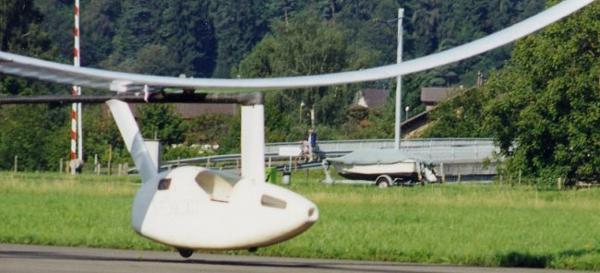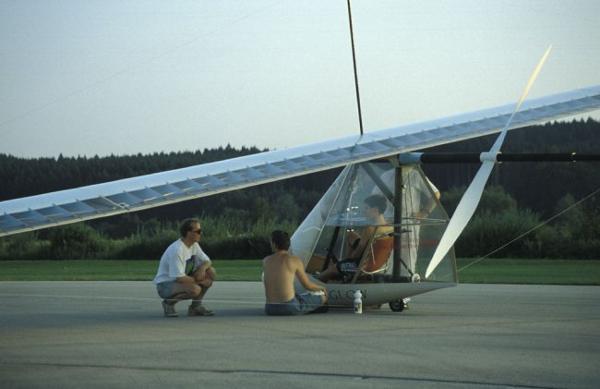Velair etc.
VELAIR
Peer Frank of Stuttgart was a former glider pilot and racing cyclist. He had flown the Pelargos 2 and the Musculair II and, with the Pelargos 3, had been involved with the aerodynamic side of the design and then flew the plane.
On leaving college in 1986, and starting to earn, he was able to afford to start his own project.
Almost a one-man project, Velair is distinguished by the low-slung pod of the fuselage to reduce interference drag. . With its nose air-intake, the pod looks like the engine-pod of a passenger plane.
Peer is designer, builder, engine and pilot.
Theoretical design and optimisation took place in 1986, using an Atari computer, and construction started in May 1987 with the help of two friends. By October 1987 they had built the wing structure, designed using the "D" nose principle, and Peer Frank decided to strength-test it on the ground. It broke. In order to get flying in a reasonable time, it was repaired and reinforced by skinning over the entire wing, - the two cell concept. The rest of the plane was built and first flight was on the 9th August 1988 without any problem.
In 1989 performance of the (engine + airframe ) had improved sufficiently to make flights of up to 3390 yards (3,100 m), the length of the runway.
VELAIR89
In 1989, a new wing was built and this variant named Velair89 Lateral control which appears satisfactory so far is by rotating wing-tips actuated by model-aircraft servos.
It first flew on the 24th September 1989 and has already flown the length of the 3390 yard (3,100 m) runway and made gentle turns.
Velair has made appearances at air-shows, and flew at the IHPVA gathering at Interlaken in 1999.
Velair flying at Interlaken in 1999. Picture Chris Roper
DA VINCI3 HELICOPTER
Since the mid-eighties, students at California Polytechnic State University at San Luis Obispo have been working on the Da Vinci helicopter project. The first versions refused to leave the floor of the basketball gymnasium where they were tested, but on the 10th December 1989, the Da Vinci 3 took off and hovered for eight seconds at a height of 8 inches powered by pilot Greg McNeil. This makes the Da Vinci 3 the world's first human-powered-helicopter to take off. Similar claims had been made about the A Day Fly in Nihon and the Vertigo helicopter originally built by Andrew Cranfield in England in the mid-eighties. But the Da Vinci is now recognised as the first human-powered-helicopter.
The Da Vinci series of helicopters have a recumbent pilot below the rotors. There are bracing wires below the rotors only. These rig to a frame which rotates with the rotors and is apparently independent of the seat-frame. Drive is to two propellers, one at each rotor-tip. This is a spool-drive, similar in principle to the Monarch wheel-drive, thereby putting a limit on duration. At the current stage of development, it would appear that the pilot has no control over the craft except vertically. Drift is restrained by cords held by people on the ground.
The Da Vinci 3 designed by Bill Paterson incorporates improvements on the previous machine made by a team led by Neal Saiki and Kyle Naydo, and included a weight reduction from 140 to 97 lbs, thinner rotor blades, a different arrangement of bracing wires, and a redesigned pilot support frame.
CYCLAIR - A PROPOSED DESIGN A design for long distance flight by Ernst Schoberl was presented to the 1987 OSTIV conference. With his experience in the design of the Musculairs, Schoberl recommends a self-centering sprung control bar, rear position propeller, chain drive with elliptical chainwheel, an autopilot, semirecumbent pilot and avoidance of Reynolds numbers below 300,000. His design showed fully sandwich covered wings with laminar flow aerofoil. The structure is a two-cell torsion box, with spar at thickest point. On the Musculair II, this structure led to turbulence just behind the spar because the presence of the spar affects the profile shape of the wing in flight. "Sandwich covering and carbon spar deform differently in flight". He claims that this can be avoided with a slightly flexible connection of the spar to the covering sandwich. Hopefully, then, the sandwich, though deforming slightly, will take up a smoothly curved shape from nose to trailing edge.
CAMBRIDGE UNIVERSITY, ENGLAND A student project under Dr Organ was "studying the feasibility of HPF" in 1990. It would appear that they chose to aim for a high-performer at the first attempt, rather than follow the course of other Universities, and gain experience on a low-tech short-hopper first. I wrote at the time "This is against the advice of the author. May they prove me wrong !"
They didn`t.
LOUGHBOROUGH UNIVERSITY, ENGLAND By early 1990, progress reached the stage of production of a gearbox and a foam cutter. Aim was for a 1992 flight of an advanced aircraft after discussion with MIT.
ORNITHOPTER
Bryn Bird of London England constructed two prototypes of his ornithopter design. This project used more modern materials and a larger wing area than any previous ornithopter attempt. There are no reports of successful flapping flight.
AIRGLOW
Airglow was designed by John & Mark McIntyre of Cambridgeshire, England. John McIntyre has a degree in marine engineering, and accompanied the Daedalus on its epic flight. Mark McIntyre is a professional model-builder. The two brothers were both keen aero-modellers, and have constructed a wide variety of contraptions including a sail-propelled-bicycle and a hot-air-balloon which carried a camera. But the author has seen that the quality of the construction evident in the family workshop is a far-cry from what the amateurishness of their boyhood projects might imply, while the same amount of enthusiasm and ingenuity is still present. They are working to a level of perfection in fabrication which is probably unprecedented in HPF. Any part which is not perfect is made again, and progress is not as swift as in some projects. At the time of Airglow's conception, no prize was on offer, so they were not in a race against anyone. They have chosen to use a carbon-fibre structure, and first had to make the equipment to produce tubes from this material. They are prepared to pass on to other HPV constructors the benefit of their experience in composite construction, and have advised the Cambridge University HPA team, the Bluebell III road vehicle team and even a visitor from Nihon University. John now produces an excellent DVD with pictures of many HPA.
John McIntyre writes :- "The wingspan of Airglow is 86 feet (26.2 m), and area 254 square feet (23.6 m2). The structure is similar to Daedalus. Carbon-fibre tube with styrofoam ribs. It was designed to withstand 2g, and on static test in September 1989, it proved satisfactory and the deflection was as predicted. Weight, based on the bits we have already weighed, will be of the order of 68 to 75 lbs (31 to 34 Kg). Wing section is DAI1335 and DAI1336, originated by Mark Drela for Daedalus. "The propeller is coaxial on the tailboom like Bionic Bat, and transmission is via bevel gears and a short length of untwisted 1/4inch(6.35mm) pitch chain. " (Beware, there is 1/4inch chain and there is 6mm chain, They don`t fit each others sprockets. Airglow uses 1/4inch.)
In June 1990, the McIntyres realised that in order to get flying in the foreseeable future, their policy of perfection in workmanship could be compromised, particularly on a part which could later be replaced by a better one. In any event they were obliged to follow this course with respect to the windscreen since the material they really wanted was not available. They wanted to use a large single sheet of Melinex, but the windscreen was made from joined sheets of acetate. The airframe was complete in July 1990, and tests were conducted to prove the control system which used a remote-control aircraft-model system except that instead of radio, the link between the pilot's control and the servos was by wires. The model servos proved satisfactory, and on one test were even able to provide a torque sufficient to overstress the control surface. This surface was replaced and calm weather was waited for. On 20th July 1990 Airglow was assembled at Duxford airfield Cambridgeshire, England early in the morning. Seventeen year old Nick Weston was in the hot seat and for the first time an attempt was made to fly the plane. On the first run, quite a lot of the runway was covered at what seemed to be surely sufficient speed, but on the runway was where the plane stayed. An adjustment was made to the elevator setting and on the second run Airglow made its first flight at 6 am. Three further flights were made, the longest being about a quarter of a mile.
Nick Weston reported that the power requirement was lower than he had expected and that he could have flown for much longer, he found it fairly easy to keep to a straight line and to hold the height between one and four feet. Problems arose only after landing, when either the plane would roll onto the grass, or a wing-tip would touch ground and yaw the plane around uncontrollably. On the fourth landing, Airglow hit a bump on the grass and the shock damaged the seat mounting. Apart form the make-shift parts mentioned above, on July 20th no door was fitted, and all the inspection panels were off, some with wires hanging out.
Since then, Airglow had been developed. The control stick position has been changed, the fuslelage fairing improved and an optical grade Melinex windscreen fitted.
A series of flights were made with instrumentation to measure the drag. This was done using anemometers fitted behind the wing.
Airglow is currently, 2007, the only operational human powered aeroplane in Britain.

Mark McIntyre, Nick Weston, and Peer Frank on the runway at Mindelheim circa 1990. Picture John McIntyre.
The Schools Competition
Open to any Youth Group in the UK, this competition was launched by the RAeS in 2006.
Youngsters have always shown their ability to pilot. Now here is encouragement for them to be involved in the creation of the machine. The conditions are far less stringent than for any previous competition. A cash prize and a trophy will be awarded annually for the flight of longest duration that year. Two ground-handlers are allowed to assist in the take-off. It can be done. The precedent for this is the Aslam HPA built by students of Dr Keith Sherwin in Singapore. Upper age limit is 18. The RAeS HPAG currently includes Dr Keith Sherwin, Dr Bill Brooks, Professor John Wimpenny, John McIntyre, Fred To, and your author Chris Roper, all of whom have designed HPA.
We are providing information and support to participating teams. HPA have been built with very modest equipment, and construction should be well within the scope of a school`s workshop. It is anticipated that flights could be performed on a typical school playing field, or similar open space. The rules also constrain that the plane must be deriggable suitable for transporting.
